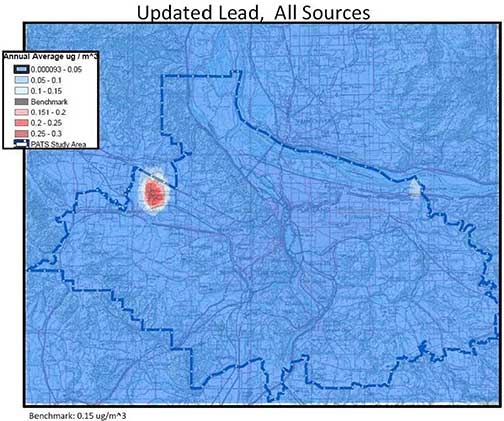 |
Previous Issues |
| Cedar Mill Community Website |
|
Search the Cedar Mill News: |
About The Cedar Mill News |
|
|||||||
| Volume 14, Issue 4 | April 2016 |
||||||
OAW looks at HIO
|
||||||
 |
| Built in 2002, Nike’s corporate hangar is aptly named Air Hangar 1 (a reference to their iconic Air Force 1 shoe) and can sustain flight operations to any of the six continents where the company’s employees and subcontractors work. |
HIO and other airports in the region generate a great deal of noise throughout the day and night hours. OAW has established an on-line aviation noise complaint form that notifies the Port, DEQ, Washington County Commissions, the City of Hillsboro and the FAA of community concerns. It can be accessed here.
OAW is extremely concerned about the lead pollution at the Hillsboro Airport. We were honored to be invited to be part of a coalition, along with Friends of the Earth, EarthJustice, the Golden Gate University Environmental Law and Justice Clinic, and Physicians for Social Responsibility, in urging the Environmental Protection Agency (EPA) to issue an endangerment finding regarding the use of leaded aviation fuel. The EPA has not yet made a final decision on this issue. For additional information, visit the EarthJustice site.
In 2007, the owner and operator of HIO, the Port of Portland (Port), estimated annual lead emissions of 0.7 tons per year during the landing and take-off (LTO) cycle of flight. The Port is now forecasting that LTO lead emissions will increase to 0.9 tons by 2021. Additional lead is released during ground run-up engine checks and the cruise phase of flight. HIO is the number one facility source of lead in Oregon. It ranks 21st among nearly 20,000 airports nationwide in lead pollution.
 |
| PATS 2005 Estimated Lead Concentrations |
HIO is a major facility source of an array of other air toxics as well. Per the 2011 Environmental Protection Agency (EPA) National Emissions Inventory (NEI), HIO is the largest facility source of acrolein, 1,3 butadiene, ethyl benzene, and acetaldehyde in Washington County. All of these air toxins are listed in the DEQ Portland Air Toxics Solutions (PATS) study as exceeding benchmark levels. PATS recommended reducing these pollutants by 81-88% depending on the specific toxin. HIO is also the largest facility source of formaldehyde in Washington County, and it is also one of the 15 toxins identified in the PATS study as exceeding benchmark levels. PATS recommended reducing this pollutant by 10%. Notwithstanding the serious health risks associated with these air toxins, no efforts have been initiated by DEQ, the Port of Portland, or the State of Oregon to protect the public from these emissions.
In addition, HIO generates a number of pollutants not included in the PATS study. In response to Clean Air Act requirements, the EPA established National Ambient Air Quality Standards (NAAQS) for six “criteria” pollutants determined to pose a danger to public health and the environment. These pollutants are lead, carbon monoxide, particulate matter (includes PM 2.5 and PM 10), ozone, nitrogen dioxide and sulfur dioxide. According to the 2011 EPA NEI, HIO is the largest facility source of elemental carbon particulate matter 2.5 and carbon monoxide and the second largest source of nitrous oxide, sulfur dioxide and particulate matter 2.5 emissions in Washington County.
Please note that when Port of Portland prepared its initial environmental assessment on the third runway proposal, it relied on readings from a DEQ monitor, located in Southeast Portland more than 16 miles from HIO, to predict these criteria pollutants, excepting lead which was estimated. The Port’s failure to actually monitor these toxins within the vicinity of the airport is alarming.
Finally, another issue impacting Washington County residents is aerial pesticide spraying. OAW is not spearheading this effort. Beyond Toxins, a non-profit environmental organization, has recently proposed three ballot measures to address this issue. For additional details see this page.
The mission of OAW is to enhance and protect the quality of life for Oregon residents by eliminating the adverse impacts of aviation activity. Issues of concern include noise intrusions, environmental pollution, climate change, health risks, social injustice, property devaluation, safety hazards, security threats, land use restrictions, and fiscal inequities. Our vision is to achieve a transparent, accountable, and sustainable aviation system that neither disregards nor diminishes the environment, livability, health, or well-being of current and future generations of Oregon residents.
For more information, and to support our efforts, visit our website or contact us at info@oregonaviationwatch.org.
![]()
Like us on Facebook for timely updates
Published monthly by Pioneer Marketing & Design
Publisher/Editor:Virginia Bruce
info@cedarmillnews.com
PO Box 91061
Portland, Oregon 97291
© 2016